Palm Reading
It is that time of year. The holidays have come and long gone, leaving nothing but the bills. Here in Canada it is the time of year when the days are cold and dreary. It is the time of year when the polar bears and dire wolves stalk the land while the minds of writers turn to excessive hyperbole. It is the dead of winter. The fortunate have all escaped to warmer and more pleasant climates, usually Florida. For the unfortunate, the briefest thought of the beaches, the sun, and the palm trees can provide that fraction of a difference in making it through the day (Fig. 1).
If you were to show someone around these parts a picture of a palm tree with no other surrounding geographical features, the first association is likely to be with Florida. After all, Florida is probably the most frequently visited palm-treed destination for individuals from this northerly part of the world. The place also tends to play up this association as well. The palm tree is prominent on the Great Seal of Florida and the state is absolutely filled to overflowing with Palm Beaches, Palm Cities, Palm Coasts, and Palm Bays, not to mention the Palm Rivers, Palm Plazas, and Palm Valleys. The point is probably made without recourse to the numerous places with palmetto in their names as well. Suffice to say that Florida has very strong associations with palm trees.
In classical antiquity, palm trees also had a very powerful geographical association. The Greek name for the date palm was phoinix, and because these trees were abundant along the southern Levantine coast, the Greeks already in the time of Homer had come to describe the region as Phoenicia (“Land of the Date Palm”). It seems not to have mattered much that the native inhabitants called it Canaan, or that its immediate neighbors tended to associate the area more closely with the cedars that grew on Mount Lebanon than with the palm trees of the coast.

Canaanites hailing from the great maritime cities of Sidon, Tyre, Arwad (Arados), and Gebal (Byblos) seem to have completely ignored the Greek name for their land in the fifth century BC when they first struck their own coinages. Instead, their money tended to feature types advertising naval power, patron deities, or relationships with the Great Kings of the Persian Empire (Fig. 2). While Greeks and Canaanites were not infrequently exposed to one another through trade and war, they did not live in close enough proximity for the Greek exonym to make much of an impact in Canaan. Ironically, it was actually the Canaanites outside of Canaan who first seem to have internalized “Phoenicia” as the name of their homeland.
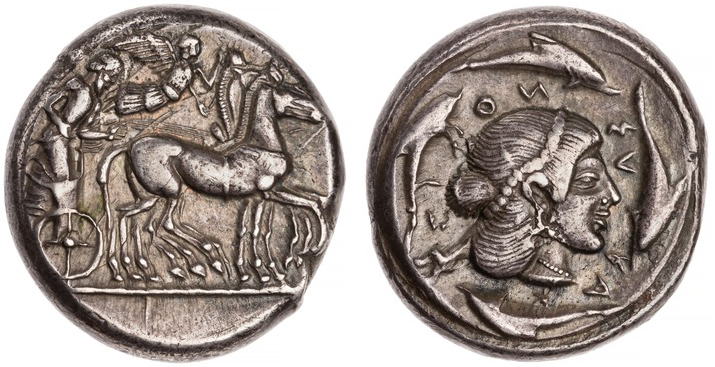
In 813 BC, the Tyrians founded the city of Carthage in North Africa. By the eighth century BC, the new colony was expanding its growing trade empire into western Sicily. The Canaanite peoples of this empire are regularly described as Punic— from Punus, the Latin name for them, which in turn is corrupted from Greek Phoinix. Since the eastern part of the island was increasingly populated by Hellenic settlements (Fig. 3), Punic traders and colonists from Carthage found themselves in much greater proximity to Greeks and their culture than Tyre and the other cities of Canaan ever did in the same period. Sharing an island—even one as large as Sicily—with the Greeks meant that over time, aspects of their culture were sure to rub off on the Punic inhabitants of western Sicily. One such aspect was the use and production of coins. Interestingly, when Punic military mints and the civic mint of Motya (a Punic colony founded in the eighth century BC) began striking coins in the late fifth and early fourth centuries BC a prominent recurring emblem was that of the palm tree, either as the main type (Fig. 4) or as a secondary element of the type (Fig. 5).
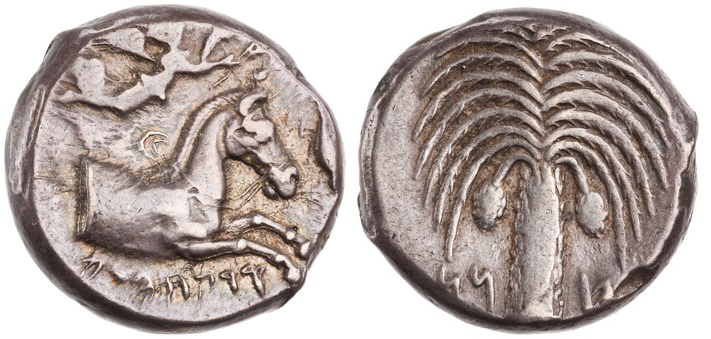
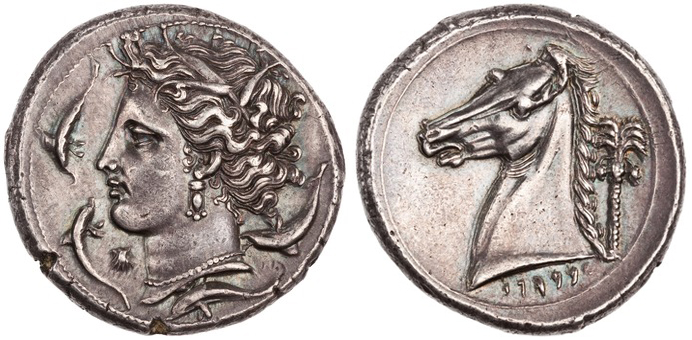
The tree almost certainly appears as a means of advertising the Canaanite ethnic origin of the issuers, but expressed in Greek terms: The palm tree presents them as Phoenicians. Evidently, when the Punic peoples adopted coinage, they also adopted the distinctly Greek iconographic language that came with it. Punning emblems used to represent the names of cities (e.g. a seal [Greek phoke] on coins of Phokaia [Fig. 6]) are almost as old as the invention of Greek coinage. The Greek palm tree emblem to establish the non-Greek origin of the issuers combined with legends written in a Semitic alphabet, make for a remarkably schizophrenic coinage.
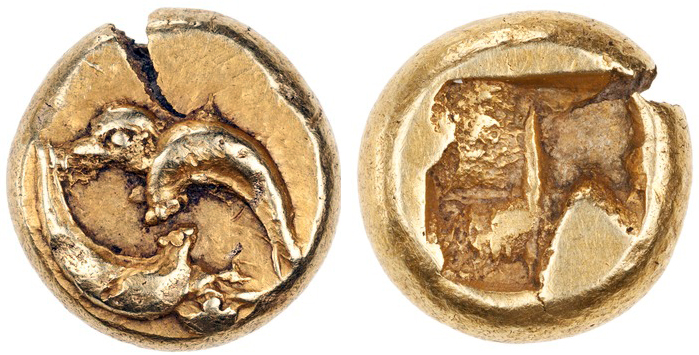
Sustained close proximity to the Greeks seems to have been the key factor in the development of a Phoenician public persona by peoples of Canaanite origin, perhaps because of the common Greek tendency to interpret other cultures in Hellenic terms (the so-called interpretatio Graeca). In Sicily, Punic peoples came to identify as “Phoenician” through their coin types early because of constant Greek contact on the island, but a similar phenomenon occurred in their homeland after the conquests of Alexander the Great (336-323 BC) established numerous Greco-Macedonian colonies in the Near East. Canaan’s northern neighbor, Syria, was aggressively colonized by Alexander’s successor, Seleukos I Nikator (320–281 BC), and therefore it is perhaps unsurprising that Arados, the northernmost Canaanite city was the first to advertise itself as “Phoenician” in the mid-third century BC. The palm tree appears on the city’s autonomous Alexanders perhaps as early as 246/5 BC. Self-identification as “Phoenician” seems to have spread along the Levantine coast and by the time of the Seleukid conquest of the region (200-198 BC), Tyre used the iconography of the palm, either as a tree or a branch, to indicate its “Phoenician” character (Fig. 7).
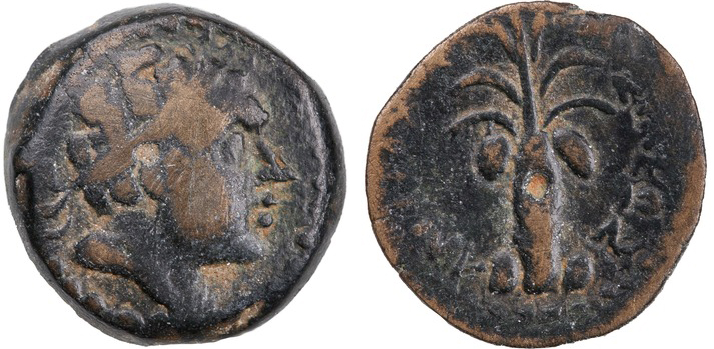
By the late second century BC, most of the other coin-issuing cities of the region also included palm branches on their coins to illustrate that they too belonged to Phoenicia, a feature that continued into the Roman Imperial period (Fig. 8).
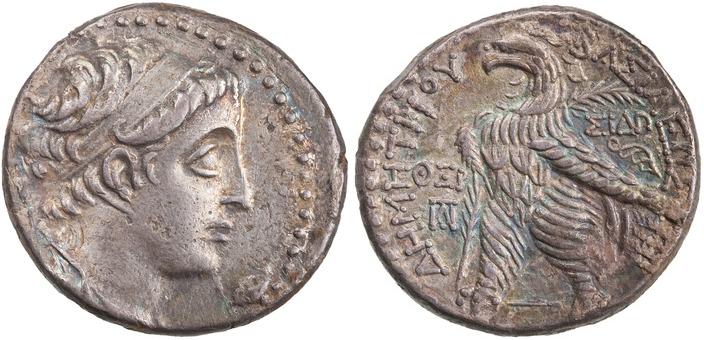
Fig. 8. Seleukid silver tetradrachm of Sidon under Demetrios II Nikator (146-139 BC) with palm branch over eagle’s shoulder. ANS 1944.100.77312.
While the fortunate golf or take refuge from the kindly sun under the shade of Florida’s palm trees at this time of year, it is worth giving a thought to the long shadow that the palm has cast over the peoples of ancient Canaan. We are told that a rose should smell as sweet by any name, but when the world turned Greek there was evidently a perceived value in accepting names and identities more fitting with the changed milieu. Maybe there is more in a name than the Bard suspected.





